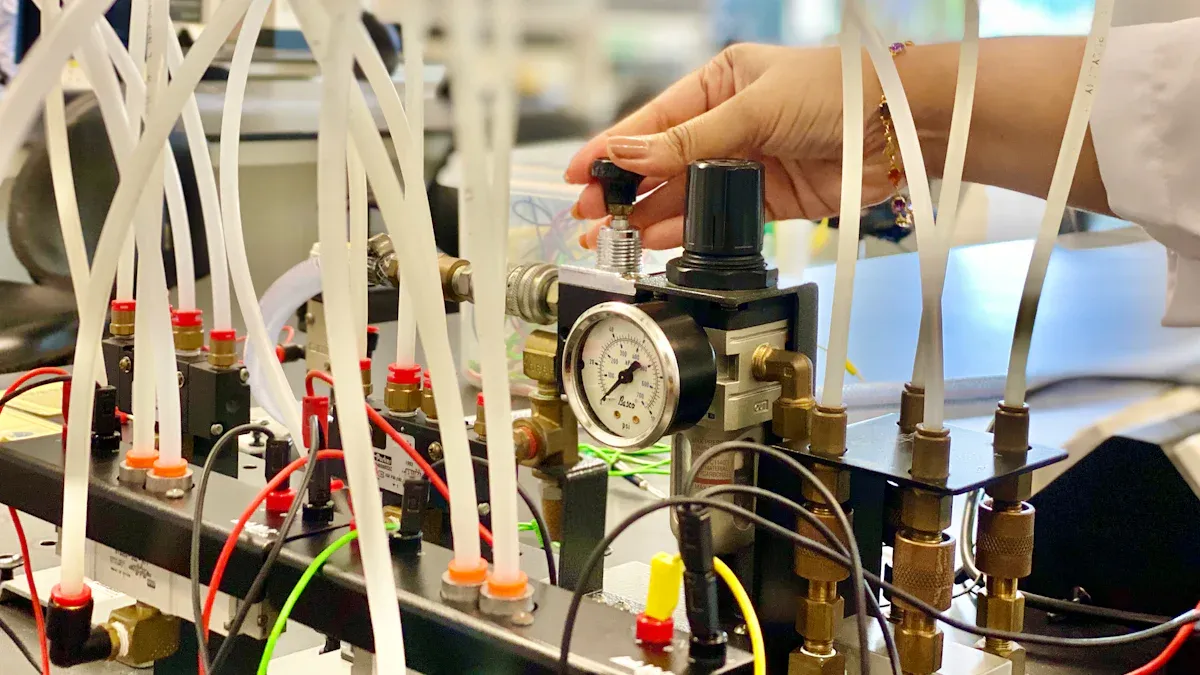A hydraulic system uses the hydraulic system working principle to transmit pressure through a confined fluid. Pascal’s Law states that pressure changes travel equally in all directions. The formula ΔP = F/A shows how a hydraulic brake system multiplies force, making heavy lifting and precise control possible in many applications.
Key Takeaways
- Pascal’s Law states that pressure applied to a confined fluid spreads equally in all directions, allowing force to be multiplied in hydraulic systems.
- Hydraulic systems use this principle to lift heavy loads or perform precise tasks by transmitting pressure through fluid from a small piston to a larger piston.
- Everyday tools like car jacks and brakes rely on hydraulic systems to make heavy lifting and stopping easier, safer, and more efficient.
Pascal’s Law and the Hydraulic System

Simple Explanation of Pascal’s Law
Pascal’s Law forms the foundation of every hydraulic system. This law states that when someone applies pressure to a confined fluid, the pressure spreads equally in all directions. The pressure does not weaken or change as it moves through the fluid. This means that a force applied at one point in the system can create an equal effect at another point, even if the shapes or sizes of the containers are different.
Scientists have tested Pascal’s Law through many experiments. One famous demonstration is Pascal’s Barrel Experiment. In this experiment, a person pours water into a long, narrow tube connected to a barrel filled with water. Even a small amount of water in the tube creates enough pressure to burst the barrel. This shows that pressure applied at the top travels equally throughout the fluid, no matter the shape or size of the container.
| Experiment/Demonstration | Description | Verification Aspect |
|---|---|---|
| Pascal's Barrel Experiment | Pressure applied at one point in a fluid is transmitted equally, bursting the barrel. | Confirms equal pressure distribution in a static fluid, supporting Pascal's Law. |
| Hydraulic Systems (jacks, lifts, brakes) | Small force on a small piston creates equal pressure, resulting in a larger output force. | Demonstrates pressure transmission and force multiplication in real-world devices. |
The mathematical formula for Pascal’s Law is:
P = F / A
where P stands for pressure, F for force, and A for area. If someone applies a force to a small piston, the pressure created is the same throughout the fluid. When this pressure reaches a larger piston, the force increases because the area is bigger. This principle allows a hydraulic system to multiply force and perform heavy tasks with little effort.
Everyday Example of Pascal’s Law
People encounter Pascal’s Law in daily life, often without realizing it. A common example is the hydraulic car jack. When a mechanic pushes down on a small lever, the force travels through the hydraulic fluid and lifts a heavy car. The pressure created by the small input force spreads equally through the fluid, allowing the larger piston to lift the car with ease.
Other examples include:
- Hydraulic brakes in cars: When a driver presses the brake pedal, the force moves through brake fluid, pressing the brake pads against the wheels.
- Hydraulic lifts: Workers use these lifts to raise heavy equipment or vehicles in garages and workshops.
- Hydraulic jacks: These tools help lift heavy objects by transmitting pressure from a small piston to a larger one.
Tip: The hydraulic system uses Pascal’s Law to make lifting, pressing, and moving heavy loads much easier and safer.
The relationship between force and area in these systems can be seen in this table:
| Concept/Formula | Description | Example/Calculation |
|---|---|---|
| Pressure formula | Pressure (P) is force (F) divided by area (A): P = F / A | - |
| Pascal's Law in hydraulics | Pressure is transmitted undiminished: P1 = P2, so F1/A1 = F2/A2 | If F1 = 100 N on piston with area A1, and A2 = 5 × A1, then F2 = 500 N |
| Force calculation | Rearranged from Pascal's Law: F2 = (A2 / A1) × F1 | Master cylinder force F1 = 500 N, diameters given, calculate F2 for slave cylinders |
| Area calculation | Area from diameter: A = π(d/2)^2 | Master cylinder diameter = 0.500 cm, slave cylinder diameter = 2.50 cm |
| Hydraulic brake example | Force multiplication through piston area difference | Input force 100 N increased to 500 N on master cylinder, then further multiplied on slave cylinders |
A simple diagram of a hydraulic press often shows a small piston connected by a pipe to a larger piston. When someone pushes down on the small piston, the pressure moves through the fluid and pushes up the larger piston. This visual helps people understand how pressure transmission and force multiplication work in a hydraulic system.
How Hydraulic Systems Work in Practice
Applying Pascal’s Law in Hydraulic Systems
Engineers design each hydraulic system to use Pascal’s Law for efficient power transmission. When a pump, powered by an engine or electric motor, pushes fluid into the system, the pressure spreads equally in all directions. This pressure moves through control valves and reaches actuators, such as cylinders or motors. The actuators then convert the fluid’s pressure into mechanical movement. This process allows the system to multiply force and perform heavy tasks with minimal effort.
- The pump creates pressurized fluid.
- Control valves direct the fluid to the actuator.
- The actuator converts fluid power into mechanical work.
- The system performs the required task, such as lifting or pressing.
Hydraulic System Examples: Lift and Press
Hydraulic systems appear in many industries. Table lifts, forklifts, and automotive lifts all use hydraulic power to raise heavy loads. Medical lifts help position patients safely. Presses in factories use hydraulic force to shape or cut materials. Each application relies on precise control and force multiplication. Engineers select components and design layouts based on the load, required movement, and safety needs.
Note: Hydraulic lift and press systems often use multiple cylinders, special valves, and safety devices to ensure smooth and reliable operation.
Main Components of a Hydraulic System
| Component | Function | Example Applications |
|---|---|---|
| Hydraulic Tank | Stores and cools fluid, removes air and debris | Construction equipment, presses |
| Pump | Converts mechanical energy into fluid power | Excavators, loaders |
| Valves | Control flow, direction, and pressure | Precision machinery, heavy equipment |
| Cylinders | Create linear motion | Cranes, presses |
| Motors | Create rotary motion | Winches, conveyor systems |
| Hoses and Pipes | Transport fluid between components | Mobile and stationary systems |
| Filters | Remove contaminants | All hydraulic systems |
| Accumulators | Store energy, absorb pressure changes | Emergency braking, energy recovery |
Key Formulas and Practical Use in Hydraulic Systems
Basic Hydraulic Formulas
Engineers rely on several key formulas to design and analyze a hydraulic system. The most fundamental formula is:
Force = Pressure × Area
This equation shows that the force produced by a hydraulic cylinder depends on the pressure of the fluid and the area of the piston. The area is calculated using the formula for the area of a circle:
Area = π × (radius)^2
In open channel flow, the hydraulic radius plays an important role. The hydraulic radius is the ratio of the cross-sectional area of flow to the wetted perimeter. A larger hydraulic radius means higher flow velocity and greater channel capacity. Manning’s Equation helps engineers estimate flow velocity in channels:
V = (1/n) × R_h^(2/3) × S^(1/2)
Here, V is velocity, n is the Manning’s roughness coefficient, R_h is the hydraulic radius, and S is the slope. This formula, developed from the Chezy formula, is widely used because it simplifies the process of estimating flow in open channels.
Using Formulas to Calculate Force
Practical calculations help users understand how formulas work in real hydraulic systems. Consider these examples:
- A hydraulic cylinder has a piston diameter of 4 inches and operates at 1500 PSI.
- Radius = 2 inches
- Area = π × (2 inches)^2 ≈ 12.57 square inches
- Force = 1500 PSI × 12.57 square inches ≈ 18,855 pounds
- A smaller cylinder with a diameter of 2 inches at the same pressure:
- Radius = 1 inch
- Area = π × (1 inch)^2 ≈ 3.14 square inches
- Force = 1500 PSI × 3.14 square inches ≈ 4,710 pounds
These examples show how changing the piston size affects the force output. By applying these formulas, engineers can design a hydraulic system that meets specific lifting or pressing requirements.
Tip: Always use consistent units when calculating force in hydraulic applications.
Pascal’s Law stands as the foundation for reliable force transmission in modern industry. Engineers trust hydraulic technology for heavy lifting and precise movement. Projects like the Burj Khalifa used hydraulic jacks to lift massive steel sections, proving their dependability. Industries such as construction, manufacturing, and agriculture rely on hydraulic equipment for efficiency and safety.
FAQ
What is the main advantage of using a hydraulic system?
Hydraulic systems multiply force, making it easy to lift or move heavy objects with little effort. This advantage helps many industries improve efficiency and safety.
How does Pascal’s Law apply to hydraulic brakes?
Pascal’s Law ensures that pressure from the brake pedal travels equally through the brake fluid. This action allows all wheels to stop the vehicle smoothly and safely.
Which industries use hydraulic systems most often?
Construction, manufacturing, agriculture, and transportation industries use hydraulic systems. These systems power equipment like cranes, presses, lifts, and winches.
Tip: Hydraulic systems provide reliable performance in demanding environments.
Post time: Jul-01-2025


